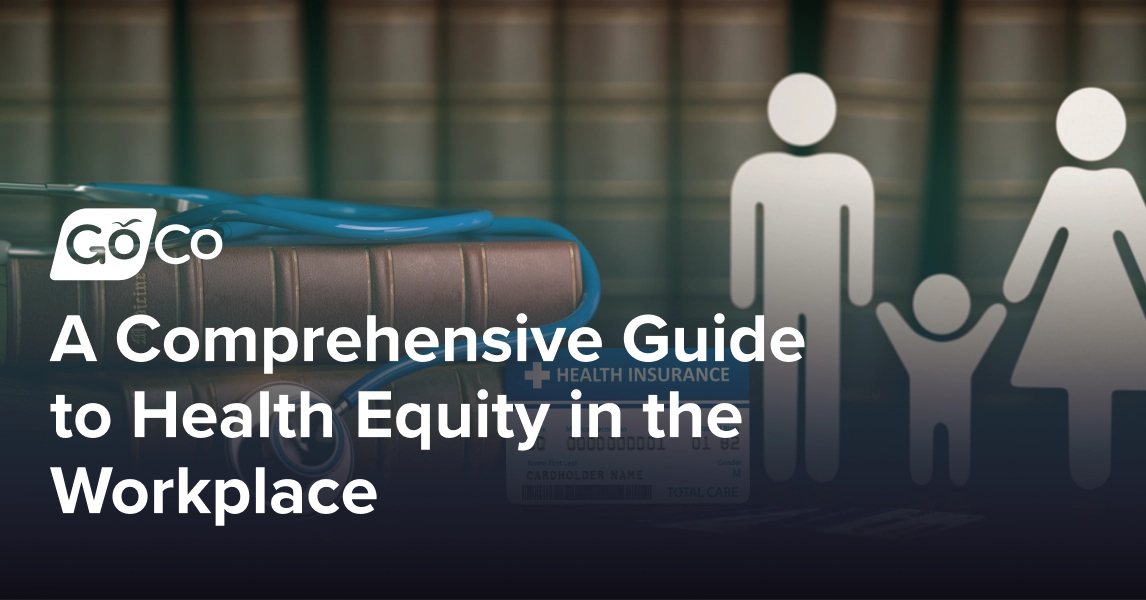A Comprehensive Guide to Health Equity in the Workplace
This guide delves into the complexities of health equity, exploring its definition, the challenges employees face, and the strategic steps companies can take to promote a healthier, more equitable workplace for everyone.
by Anna Coucke - August 7th, 2024
Health equity is a critical component of creating an inclusive working environment where all employees can thrive — but what exactly does it entail?
While the concept might seem broad, its implications are far-reaching, impacting everything from employee morale and productivity to organizational reputation and the bottom line.
This guide delves into the complexities of health equity, exploring its definition, the challenges employees face, and the strategic steps companies can take to promote a healthier, more equitable workplace for everyone.
What is Health Equity?
According to the World Health Organization (WHO), health equity refers to the opportunity for everyone to attain their full health potential, no matter their social position or other circumstances. It's about ensuring that everyone has fair and just opportunities to be healthy. This concept extends beyond simply providing healthcare access; it means creating an environment where all individuals can thrive.
In the workplace, health equity simply means that every employee, regardless of their background, has the same chance to achieve optimal health and well-being. It involves addressing systemic barriers that prevent certain groups from enjoying good health, such as race, ethnicity, gender, socioeconomic status, and disability.
What Are Some Examples of Health Inequity in the Workplace?
Health inequity in the workplace is complicated and often manifests in various forms. One common example is the disparity in access to healthcare benefits. According to a study by the Kaiser Family Foundation, employees in lower-wage positions are more likely to have limited or no health insurance coverage, impeding their ability to receive preventive care, manage chronic conditions, or address urgent health needs. This lack of coverage can lead to significant health disparities and financial hardship.
Beyond healthcare access, the overall nature of lower-wage jobs often contributes to poorer health outcomes. These positions frequently involve physically demanding tasks, irregular and extensive hours, and limited job security. Such factors can lead to chronic stress, physical exhaustion, and mental health challenges.
For instance, financial strain due to low wages can increase anxiety and depression, while the constant pressure of job insecurity can contribute to overall mental health decline. Additionally, the physical demands of many lower-wage jobs can result in chronic pain and fatigue.
Furthermore, workplace culture and conditions can exacerbate health inequities. Psychology research has found that employees in lower-wage positions often experience less autonomy, limited opportunities for advancement, and higher levels of job dissatisfaction. These factors can contribute to feelings of helplessness, lack of control, and increased stress. Moreover, discrimination and stigma based on socioeconomic status can further negatively impact the mental and physical health of these workers.
Why Does Health Equity Matter in the Workplace?
Health equity in the workplace is crucial for several reasons; providing benefits for both employees and the organization:
Benefits for Employees
Improved Health Outcomes: When employees feel supported and valued, their overall health improves. This leads to reduced absenteeism, higher morale, and increased job satisfaction.
Increased Productivity: A healthy workforce is a more productive workforce. By addressing health disparities, companies can create an environment where all employees can reach their full potential.
Fairness and Inclusion: Promoting health equity demonstrates a commitment to fairness and inclusion, fostering a positive and supportive workplace culture.
Benefits for the Organization
Reduced Healthcare Costs: A healthier workforce leads to lower healthcare costs for both employees and the company.
Improved Employee Retention: Employees who feel valued and supported are more likely to stay with a company.
Enhanced Reputation: A company committed to health equity builds a strong reputation as an employer of choice.
How Companies Can Promote Health Equity
Successfully addressing the factors that contribute to health inequity requires an approach that focuses on improving access to healthcare, enhancing working conditions, and promoting a culture of equity and well-being for all employees.
Employers must first realize that accessible, adequate healthcare looks different for each person. While some employees may be attracted to extensive (and expensive) family healthcare plans to fit their needs, other workers may not need the same level of health coverage and be more interested in budget-friendly options like health savings accounts (HSAs) and telehealth providers.
To better understand your organization’s workforce and their health needs, evaluate the effectiveness of your current benefits offerings using employee surveys, focus groups, and benefits audits. This will help you understand what benefits employees currently find most valuable, as well as any gaps in your offerings.
Beyond benefits, it is crucial to foster a company culture of inclusiveness, equity, and understanding. To do so, organizations can conduct regular diversity and inclusion training, establish Employee Resource Groups (ERGs), and encourage the use of inclusive language in all communications.
Final Thoughts
Achieving health equity in the workplace requires an overall business strategy that addresses systemic barriers, fosters a culture of inclusion, and prioritizes the well-being of all employees.
By understanding the challenges faced by different employee groups and implementing targeted strategies, organizations can create a workplace where everyone has the opportunity to reach their full health potential – leading to a stronger, more resilient organization that thrives in the long term.
Recommended Posts
How to Improve Employee Experience with eNPS [+template]
Blog Articles
Search...
Product
GoCo
Resources
Articles
eBooks
Webinars
Customer Stories





